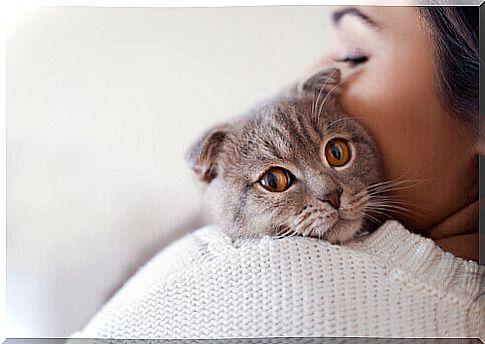The Feline Leukemia Virus: Causes, Symptoms And Treatment

Few people know that a large portion of the global feline population, between 2 and 15%, will contract the feline leukemia virus at some point in their life. The problem, in fact, is that on many occasions their masters do not notice it. Knowing the causes and symptoms of this dangerous communicable disease, which can be fatal, is essential in order to prevent and treat it.
The retrovirus of feline leukemia
A retrovirus is composed of single-stranded RNA. This virus replicates thanks to the action of an enzyme called Reverse Transcriptase, which allows RNA to be converted into DNA for subsequent introduction into the host cell’s DNA. Once implanted, the virus begins to multiply.
The main form of contagion of the feline leukemia virus is contact with the body fluids of another infected specimen. If a cat bites another, or comes into contact with its saliva, urine or feces, the infection is immediate. Even a mother can infect all her babies through her mother’s milk.
Cats with the greatest risk of infection are those most exposed to contact with sick individuals. We are talking, for example, about stray cats or even those who run away from home. Without forgetting the other domestic felines, carriers of the virus, which however has not yet been diagnosed and which, unfortunately, are a real loose cannon for those around them.
Main symptoms
The disease begins to manifest months and even years after the infection. This is why treatments are often started when it is too late and only after the infected specimen has already transmitted the retrovirus to other animals. During its early stages, the following symptoms may be observed :
- Loss of appetite.
- Progressive weight loss.
- Presence of larger lymph nodes.
- Dull coat and hair loss.
- Persistent fever.
- Pale gums and mucous membranes.
- Gingivitis, inflammation of the gums and gastroenteritis.
- Infections of the urinary tract, skin and upper respiratory tract.
- Seizures, behavioral changes and other neurological disorders.
- Sight diseases.
- Abortion and other problems in the reproductive system.
Diagnosis
In order to diagnose the feline leukemia virus, veterinarians usually perform two tests that detect the presence of a protein component of the virus called FeLV P27.
The first, called ELISA, is usually used as the primary screening test . An early diagnosis goes hand in hand with the periodic checks by the vet that every responsible owner should guarantee to their four-legged friend.
If this first test is positive, the second test, called IFA, in its English acronym , is performed. It is used to confirm the diagnosis and determine the progress of the disease. The latter test detects the presence of viral particles in lymphocytes, which usually occurs when the disease is now widespread.
Treatment and prevention
Nowadays, there is no definitive cure. Some therapies are known that have been shown to be effective in reducing the amount of viral particles in the bloodstream. However, as is often the case with major cancer treatments, their side effects can be devastating.
The only way to ensure your cat’s well-being is to ask your veterinarian for palliative care to counteract the symptoms of the viral condition, in case of infection, or to prevent it, if the animal is healthy. One way to achieve this is to keep the cat protected inside the house, where it does not run the risk of coming into contact with the body fluids of other potentially infected cats.
There is a relatively effective, but not definitive, vaccine that can reassure owners that they know in advance that there are carriers of the virus nearby. You must keep in mind, however, that this treatment is scarcely widespread and as the only preventive measure, the only certainty comes from preventing any contact with other cats that do not know each other.









